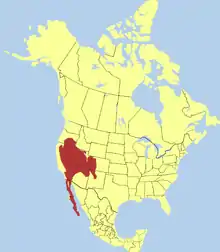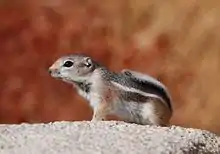| White-tailed antelope squirrel | |
|---|---|
 | |
| White-tailed antelope squirrel in Southern Utah | |
| Scientific classification | |
| Domain: | Eukaryota |
| Kingdom: | Animalia |
| Phylum: | Chordata |
| Class: | Mammalia |
| Order: | Rodentia |
| Family: | Sciuridae |
| Genus: | Ammospermophilus |
| Species: | A. leucurus |
| Binomial name | |
| Ammospermophilus leucurus (Merriam, 1889) | |
 | |
| Distribution map of the white-tailed antelope squirrel—Ammospermophilus leucurus | |
The white-tailed antelope squirrel (Ammospermophilus leucurus) is a diurnal species of ground squirrel, scientifically classified in the order Rodentia and family Sciuridae, found in arid regions of the southwestern United States and the Baja California Peninsula of northwestern Mexico.
Distribution
The white-tailed antelope squirrel's geographical range extends north to south from southwestern Oregon to New Mexico, and east to west from western Colorado to Baja California, Mexico.[2][3][4]

Home range and population density
This species of squirrel has an average home range of 14.9 acres (60,000 m2), and utilizes approximately 4 acres (16,000 m2) in its daily activities.[5] Throughout much of the squirrel's range, especially in Utah, the population density fluctuates greatly, with periods of high density followed by periods of low density.[2][6] Average population density also varies by season, with higher density in autumn relative to late spring.[2][7]
Ecology
The white-tailed antelope squirrel is commonly spotted in arid habitats throughout the southwestern United States.[2] Throughout this range, Ammospermophilus leucurus is omnivorous, feeding primarily on foliage (10%-60% of its diet), seeds (20%-50%), arthropods, and to a lesser extent, vertebrates (mainly lizards and rodents; predatory behavior by ground squirrels has been noted[8][9][10][11]).[12] In conjunction with being a predator, the white-tailed antelope squirrel is also prey to many larger animals, including raptors, various canids, and snakes.[2][3][4][6] These squirrels are not only preyed upon by large predators, but they also fall victim to many diverse ectoparasites. These include various ticks, fleas, mites, lice, and a couple species of parasitic larvae.[2]
Behavior
Antelope squirrels are active most during the cooler parts of the daylight hours, avoiding midday as much as possible.[2][13] Although these animals live in hot and arid climates, the white-tailed antelope squirrel is diurnal, meaning heat gain from metabolic activity could be a problem. However, compared to direct exposure of heat from the sun, metabolic heat gain contributes little to the overheating of this species.[2][13] This diurnal activity pattern may be contributed to predation patterns.[14] Selective pressures may have led to this species avoiding nighttime activity due to increased predation by nighttime predators. This behavior is controlled by the squirrels' natural circadian rhythms, and research has shown these rhythms to be highly important in keeping these diurnal activity patterns intact.[14]
Reproduction
Timing
White-tailed antelope squirrels' reproductive receptiveness in females and reproductive capability in males peaks in early spring.[15] It only takes the squirrels one year to become sexually mature and begin reproducing; typically, antelope ground squirrels will produce one large litter per year.[15]
Geographical variation
Geographical factors, and thus environmental factors, weigh heavily on Ammospermophilus leucurus' reproductive cycle length and average litter size.[16] Specifically, this variation is seen best when comparing the northern and southern extents of the antelope ground squirrels' distribution. In Oregon, which is the northernmost extent of the squirrels' range, reproductive cycles are relatively short, and the average litter size is 9.3. However, in Baja California, the southernmost extent of the squirrels' range, reproductive cycles last half of the year, and the average litter size is 5.9.[16]
See also
References
- ↑ Linzey, A.V.; Timm, R.; Álvarez-Castañeda, S.T.; Castro-Arellano, I.; Lacher, T. (2017) [errata version of 2016 assessment]. "Ammospermophilus leucurus". IUCN Red List of Threatened Species. 2016: e.T42452A115189458. doi:10.2305/IUCN.UK.2016-3.RLTS.T42452A22251719.en. Retrieved 10 March 2022.
- 1 2 3 4 5 6 7 8 "Archived copy" (PDF). www.science.smith.edu. Archived from the original (PDF) on 30 October 2005. Retrieved 15 January 2022.
{{cite web}}: CS1 maint: archived copy as title (link) - 1 2 Hall, E. R. 1946. Mammals of Nevada. University of California Press, Berkeley, 710 pp.
- 1 2 O'Farrell, M. J.; Clark, W. A. (1984). "Notes on the white-tailed antelope squirrel, Ammospermopfilus leucurus, and the pinyon mouse, Peromyscus true, in north central Nevada". The Great Basin Naturalist. 44: 428–430.
- ↑ Bradley, W.G. and J.E. Deacon (1965). "The biotic communities of southern Nevada," Univ. Nevada, Desert Research Institute Preprint, 9: 1-74 plus indices.
- 1 2 Fauntine, R. W. (1946). "Biotic communities of the northern desert shrub biome in western Utah". Ecological Monographs. 16 (4): 251–310. doi:10.2307/1961637. JSTOR 1961637.
- ↑ Bradley, W. G. (1967). "Home range, activity patterns, and ecology of the antelope ground squirrel in southern Nevada". The Southwestern Naturalist. 12 (3): 231–252. doi:10.2307/3669112. JSTOR 3669112.
- ↑ Green, M. M. (1925). "Notes on some mammals of Montmorency County, Michigan". J. Mammal. 6 (3): 173–178. doi:10.2307/1373628. JSTOR 1373628.
- ↑ Bailey, B (1923). "Meat-eating propensities of some rodents of Minnesota". J. Mammal. 4 (2): 129. doi:10.1093/jmammal/4.2.129.
- ↑ Johnson, A. M. (1922). "An observation of the carnivorous propensities of the gray gopher". J. Mammal. 3 (3): 187. doi:10.1093/jmammal/3.3.187.
- ↑ Bridgwater, D. D.; Penny, D.F. (1966). "Predation by Citellus tridecemlineatus on other vertebrates". J. Mammal. 47 (2): 345–346. doi:10.2307/1378145. JSTOR 1378145.
- ↑ Bradley, W. G. (1968). "Food habits of the antelope ground squirrel in southern Nevada". Journal of Mammalogy. 49 (1): 14–21. doi:10.2307/1377723. JSTOR 1377723.
- 1 2 Chappell, M. A.; Bartholomew, G. A. (1981a). "Standard operative temperatures and thermal energies of the antelope ground squirrel Ammospermopfilus leucurus in winter and summer". Physiological Zoology. 54: 215–223. doi:10.1086/physzool.54.2.30155822. S2CID 87390473.
- 1 2 DeCoursey, Patricia J.; Krulas, Jill R.; Mele, Gary; Holley, Daniel C. (1997). "Circadian Performance of Suprachiasmatic Nuclei (SCN)-Lesioned Antelope Ground Squirrels in a Desert Enclosure". Physiology. 62 (5): 1099–108. doi:10.1016/S0031-9384(97)00263-1. PMID 9333206. S2CID 44970274.
- 1 2 Kenagy, G.; Bartholomew, G. (1979). "Effects of day length and endogenous control on the annual reproductive cycle of the antelope ground squirrel, Ammospermophilus leucurus". Journal of Comparative Physiology. 130 (2): 131–136. doi:10.1007/bf00611047. S2CID 24443307.
- 1 2 Whorley, J. R.; Kenagy, G. J. (2007). "Variation in reproductive patterns of antelope ground squirrels, Ammospermophilus leucurus, from Oregon to Baja California". Journal of Mammalogy. 88 (6): 1404–1411. doi:10.1644/06-mamm-a-382r.1.
- "Ammospermophilus leucurus". Integrated Taxonomic Information System. Retrieved 18 March 2006.
